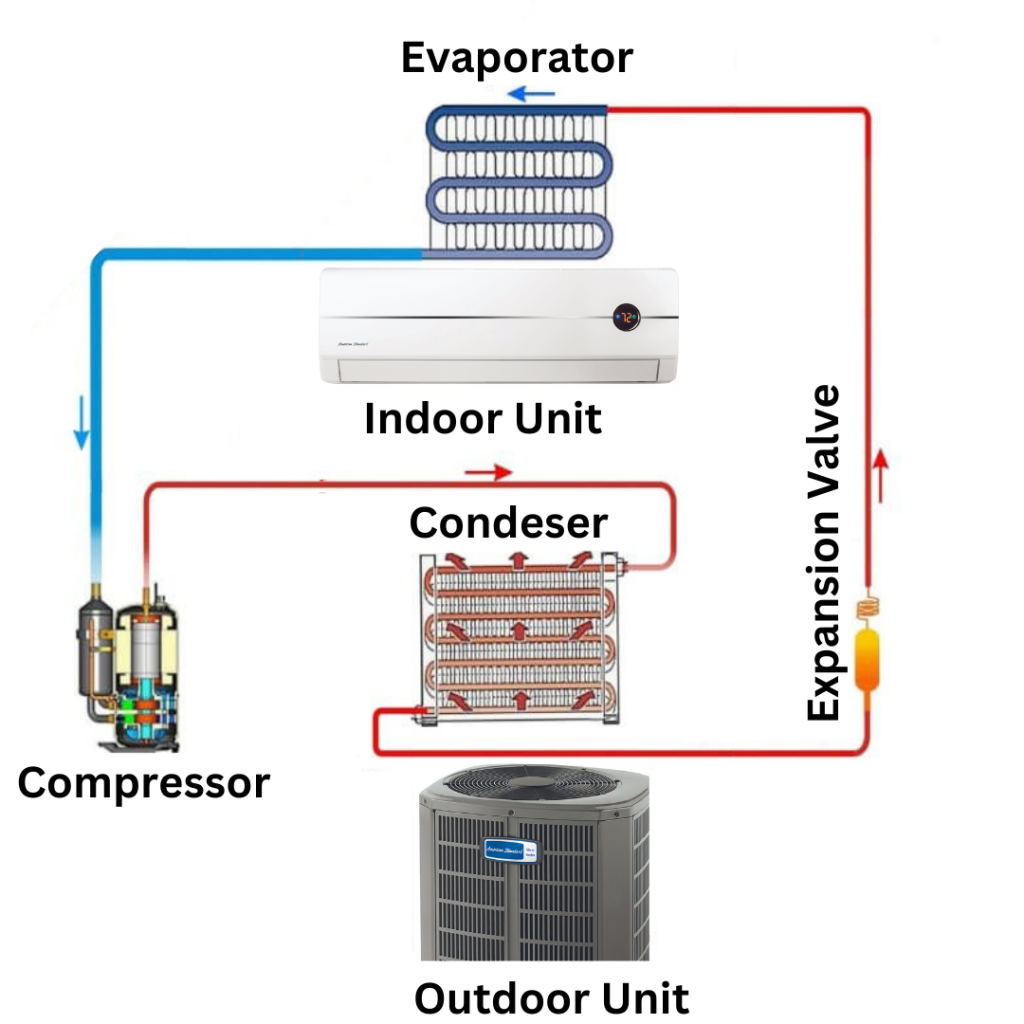Introduction
Air conditioning has dramatically evolved from a luxury to a necessity, significantly enhancing our living and working environments. The core of air conditioning lies in its ability to cool and dehumidify indoor air, making hot climates more bearable and indoor spaces more comfortable. At its heart, an A/C system consists of a compressor, a condenser, an expansion valve, and an evaporator. These components work together in a continuous cycle to transfer heat from the inside of a building to the outside, cooling the indoor space in the process.
Air Conditioner Core Components and Their Functions
Compressor
Often referred to as the heart of the air conditioning system, the compressor plays a pivotal role in the refrigeration cycle. It pumps the refrigerant throughout the system, increasing the pressure and temperature of the refrigerant gas. This process is crucial for enabling the refrigerant to absorb heat from the indoor air and release it outdoors.
Condenser Coil
Positioned outside the building, the condenser unit acts as the heat dissipater. As the pressurized refrigerant gas passes through the condenser coil, it releases its heat to the outside air. This heat release causes the refrigerant to cool down and condense into a liquid form, ready for the next phase of the cooling process.
Expansion Valve
Serving as a critical regulatory component, the expansion valve controls the flow of the cooled, liquid refrigerant into the evaporator coil. It reduces the pressure of the refrigerant, allowing it to expand and cool further. This sudden drop in pressure and temperature prepares the refrigerant to absorb heat effectively in the evaporator.
Evaporator Coil
Located inside the building, the evaporator coil is where the magic of cooling happens. The cold, low-pressure liquid refrigerant absorbs heat from the indoor air as it passes over the coil, causing the refrigerant to evaporate back into a gas. This process effectively removes heat and moisture from the indoor air, circulating cool, dehumidified air back into the space.
The Continuous Cycle of Comfort The refrigeration cycle is a continuous, closed-loop process that efficiently transfers heat from the indoors to the outdoors, maintaining a cool and comfortable indoor environment.

Different Types of Air Conditioners
Window A/Cs
Ideal for cooling single rooms, window A/C units are compact and designed to fit in standard window frames. They are a cost-effective solution for small spaces or for those living in rental apartments where modifications are limited.
Portable A/Cs
Portable A/Cs are freestanding units that can be moved from room to room. They are suitable for spaces where window configurations prevent the installation of window units or in buildings where permanent installations are not allowed. They require venting through a window but offer flexibility in placement.
Central (Ducted) A/Cs
Central A/C systems are designed for cooling multiple rooms or an entire building. They consist of a large compressor unit located outside and an indoor coil installed in conjunction with your furnace or air handler. Central A/C is ideal for homes and offices with duct-work in place, offering an efficient solution for large spaces.
Ductless Mini-Split A/Cs
Ductless mini-split air conditioners provide a versatile solution for homes without existing duct-work, featuring an outdoor compressor unit connected to one or more indoor air handling units. These are perfect for adding air conditioning to homes with non-ducted heating systems or in new additions where extending or installing duct-work is not feasible.

Considering Air Conditioners Sizes and Capacities
Understanding BTU and Ton
The terms BTU and Ton are critical in understanding AC capacity. A higher BTU or Ton rating indicates a more powerful air conditioning unit capable of cooling a larger space. To calculate the required BTU for a room, you can use a standard formula that factors in the room’s area, insulation, and other conditions mentioned above. Typically, a room measuring 150 square feet would need an A/C unit rated at approximately 3,000 BTU, while larger spaces would require units with higher BTU ratings.
The capacity of an air conditioner, represented in British Thermal Units (BTU) and Tons (where one Ton equals 12,000 BTU), essentially measures its cooling power. Let’s delve deeper into the factors influencing the size and capacity of an A/C unit required for a space:
Room/Area Size: Square Footage as a Primary Indicator
The square footage of the area to be cooled stands as the basic metric in determining the appropriate BTU capacity. A basic rule of thumb is that approximately 20 BTU is needed for every square foot of living space. However, this figure can vary based on other influencing factors such as room layout, the height of the ceilings, and the area’s general climate.
Insulation Quality: A Critical Efficiency Factor
The insulation quality of your space can significantly influence the cooling requirements. Well-insulated rooms retain cool air more effectively, reducing the workload on your AC unit and thereby requiring less BTU capacity for cooling. Conversely, spaces with poor insulation might lose cool air rapidly, necessitating a unit with a higher BTU rating to maintain comfortable temperatures.

Ceiling Height: The Volume of Air to Cool
Ceiling height impacts the volume of air within a room that needs cooling. Standard calculations often assume an 8-foot ceiling, so rooms with higher ceilings contain more air and thus require an air conditioner with a greater cooling capacity. Adjusting BTU calculations to account for ceiling heights above the standard can ensure that your A/C unit effectively manages the larger air volume, maintaining a comfortable environment throughout the space.
Occupancy: Human Heat Output
The number of people regularly occupying a space can affect its thermal load. Each person can add approximately 600 BTU to the room’s cooling requirement. In spaces where large gatherings are common, such as conference rooms or living areas, accounting for human heat output in your AC capacity calculations is crucial for achieving the desired comfort levels.
Windows and Sunlight: The Greenhouse Effect
Large windows, especially those receiving direct sunlight, can significantly raise a room’s temperature, mimicking a greenhouse effect. This natural heating can counteract your A/C’s cooling efforts, requiring a unit with a higher BTU capacity to overcome the added heat. Factors such as window size, orientation, and whether they’re shaded play into how much additional cooling capacity is needed to offset the increased thermal load.
Other Important Factors in Choosing an A/C
Choosing the right air conditioner for your needs extends beyond BTUs and Tons; several other factors play a crucial role in ensuring you get the most out of your investment, both in terms of comfort and cost-efficiency. Let’s delve deeper into some of these critical aspects:
Efficiency and Seasonal Energy Efficiency Ratio (SEER) Ratings
The SEER rating is a key metric for gauging an air conditioner’s efficiency. Essentially, the SEER rating tells you how much cooling your A/C will provide per unit of energy it consumes.
In Canada and the United States, modern air conditioners typically have SEER ratings ranging from 13 to 25+. Higher ratings equate to greater energy efficiency, translating to lower electricity bills and a reduced environmental impact over the lifespan of the unit. For example, upgrading from an older model with a SEER rating of 8 to a new model with a SEER rating of 16 can halve your cooling costs.
Inverter Technology: Efficiency and Quiet Operation
Inverter technology in air conditioners represents a significant advancement in energy efficiency and noise reduction. Unlike traditional A/C units that operate the compressor at full power or turned off completely, inverter A/C units can vary the compressor’s speed. This ability to adjust means the unit can work at lower power levels for longer periods, maintaining a more constant and precise room temperature. The benefits include reduced energy consumption (as the compressor doesn’t have to start and stop frequently), a quieter operation due to less drastic changes in speed, and an extended lifespan for the compressor.
Noise Considerations: Ensuring Peace and Quiet
A/C Noise Levels: When it comes to air conditioners, the noise level can be a significant consideration, especially in spaces meant for rest and relaxation like bedrooms. Noise levels for A/C units are measured in decibels (dB), with lower ratings indicating quieter operation. Many modern air conditioners are designed with noise reduction technologies, producing sound levels as low as 25 dB, comparable to the rustle of leaves.
Warranty and Brands: Investing Wisely
A robust warranty can safeguard your A/C investment, covering significant repairs and defects over a specified period. Look for warranties that cover both parts and labor for the longest feasible term. In Canada, reputable air conditioner brands known for their reliability, customer service, and efficient performance include:
Lennox: Offers some of the highest SEER ratings available, with models boasting up to a 28 SEER rating.
Carrier: Known for inventing modern air conditioning, Carrier continues to be a leader in high-efficiency AC units.
Trane: Offers durable units with high SEER ratings, popular for their reliability.
Mitsubishi Electric: A leader in ductless and inverter-driven systems, Mitsubishi Electric is renowned for its quiet and efficient models.
American Standard: Known for their Reliability and Durability, High Energy Efficiency, and Quiet Operation





2 Responses
Are the Air Conditioner installation prices shown on your website inclusive of coil and pad.
Hi,
Yes all of our Prices include coil and pad installation.